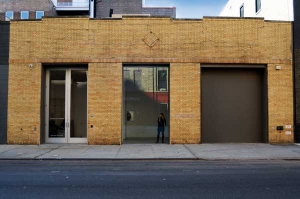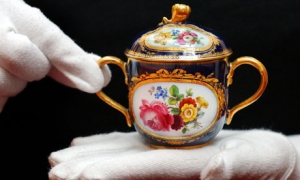|
Displaying items by tag: Art Dealers
The owners of Art Miami, a leading contemporary and modern art fair, have acquired New York’s Downtown Fair for an undisclosed price. The inaugural Downtown Fair will be held from May 8 through May 11 at the 69th Regiment Armory in New York City at the same time as Frieze New York. So far, around 50 contemporary art dealers have signed on to participate in the show.
Art Miami Partner and Director, Nick Korniloff, will direct the first edition of the Downtown Fair along with a management staff comprised of experienced marketing and exhibitor services professionals. Korniloff released a statement saying, “"We will deliver a well-vetted show that features a quality roster of artists that are represented by important international galleries. The advisory committee of dealers will insure that galleries are making every effort to show quality works that are fresh to the market."
In fall 2013 a Berlin/Hong Kong-based entrepreneur will launch Larry’s List, a database of over 3,000 international art collectors, to help galleries and art dealers find new buyers. Galleries will pay between $9 and $19 to view a profile, while artists can search their collectors for free.
Founder Magnus Resch assembled a team of 25 art market researchers who combed 27,000 sources worldwide. Resch claims that his endeavor is the most comprehensive global research project carried out on art collections. His goal is to have art dealers purchase profiles to target emerging markets. For example, if a New York-based dealer is trying to get in on the art boom in Hong Kong, they will have an accessible way to identity new customers in a largely unfamiliar market.
Larry’s List is headquartered in Hong Kong and has an office in Berlin along with regional contributors.

The Swiss government has launched a website that will help claimants, museums, and researchers track Nazi-looted artworks that have made their way to Switzerland. Switzerland became a hub for Nazi plundered artworks following World War II. The country was a popular place for Jewish art dealers who were fleeing the Nazis and many Swiss museums, collectors and dealers acquired works stolen from the Jews by the Nazis.
The new site will provide visitors with guidance on provenance research, links to relevant databases and archives, and details on Swiss museums’ own analyses of their collections. Switzerland is one of 44 countries that sanctioned the Washington Principles on returning Nazi-looted art in public collections in 1998. Under the policy, governments agreed to find “just and fair” solutions for the victims of Nazi plundering and their heirs as well as to allocate resources to identifying looted art. In spite of Switzerland’s cooperation, it is still believed that there is a fair amount of Nazi-looted artworks in Swiss collections. Provenance research has only been conducted among a select few of the government museums, private collections, and foundations that have artworks from this tragic period.
Switzerland’s newly launched website for tracking Nazi-looted artworks is www.bak.admin.ch/rk.

Christie’s International announced that they will be closing their Haunch of Venison subsidiaries in New York and London in March 2013. The gallery in Chelsea will close after its exhibition, How to Tell the Future from the Past, ends its run on March 2. The London gallery, known as the Yard, will be converted to a permanent exhibition and sales space for Christie’s private sales department.
Founded by art dealers Harry Blain and Graham Southern in 2002, Haunch of Venison represents and exhibits the works of emerging and established contemporary artists. The gallery’s name comes from the London courtyard, Haunch of Venison Yard, where it was originally based. Christie’s bought the gallery, which had branches in London, Berlin, and New York, in 2007. Haunch of Venison’s Berlin branch closed in 2010, the same year Blain and Southern left Haunch to start a new gallery, BlainSouthern.
Christie’s decision to shutter the Haunch of Venison galleries came as private sales have been gaining ground for the auction house. The restructuring will focus the company’s attention on those private sales rather than working as a primary gallery representing artists. Haunch of Venison has also withdrawn from the upcoming European Fine Art Fair in Maastricht.

The most expensive Chinese work of art at auction is still not paid for, more than a year after it was bid to 51.6 million pounds ($83 million).
The elaborately decorated Qing-dynasty porcelain vase had been found in a routine house clearance and was included in a sale of antiques on Nov. 11, 2010, by Bainbridges of west London. Its price was more than 50 times the presale estimate and the auction house ceased to comment after several months passed without payment.
Payment is still awaited, a dealer with knowledge of the matter said in an interview. Though some money has changed hands, it doesn’t look as if settlement is imminent, he said.
The record price was the most spectacular in recent sales that saw Asian clients bid multiples of the estimates for rare objects made for Chinese emperors. Bidding hasn’t always been translated into final payment in an international trade that is now valued at $10 billion.
Auctioneer Peter Bainbridge, who broke his hammer as the record was set, wasn’t prepared to publicly comment when visited by Bloomberg News in his West Ruislip auction rooms.
“I’ve signed a confidentiality clause with the buyer,” said Bainbridge, dressed in a frayed crew-neck sweater as he moved pieces of Victorian furniture entered into his next general sale. He would not confirm that the successful bidder on the vase had failed to settle the bill, nor that some money had changed hands.
Hong Kong Offer
“Once you accept a part-payment, your hands are tied,” said the London dealer John Berwald. “Perhaps they should have just canceled the deal and re-offered the vase in Hong Kong. I believe it’s 100 percent genuine. Second time around, it could be worth at least 20 million pounds.”
The piece, thought to be associated with the Qianlong Emperor, went to an agent in the room bidding on behalf of a Chinese collector. The vase featured a pierced “reticulated” body painted in a famille rose palette, and was discovered in the London suburb of Pinner. It was owned by a retired solicitor, Tony Johnson, and his mother Gene, according to the U.K.’s Daily Mail newspaper. The earlier history of the vase isn’t known.
The reluctance of Bainbridges’ Chinese buyer to settle the record-breaking bill has led other auction houses to ask for deposits on high-value works at Asian art sales.
Paris-based Asian-art specialist Pierre Ansas required clients to leave a 200,000 euro ($265,000) deposit to bid on a Qianlong-period Imperial scroll painting and seal offered at auctions in Toulouse, France, on March 26.
Unpaid Seal
The scroll was bid to a record 22.1 million euros and the seal to 12.4 million euros, both by Chinese clients. While the invoice for the scroll was settled within three months, only 2.2 million euros has so far been paid for the seal, Ansas said in a telephone interview.
“The buyer has until Jan. 10 to pay the rest,” said Ansas. ”Otherwise we will re-offer the seal in March. The valuation will be lower then -- maybe 5 or 6 million euros -- and the owners will sue for the difference between the prices.” In the event of the first buyer defaulting, the partial payment of 2.2 million euros will not be returned, said Ansas.
The successful bidder in Toulouse was a Hong Kong dealer representing a Chinese collector.
“He said he couldn’t pay because his client has lost a lot of money in China,” said Ansas. “The economy isn’t so good now. It’s a tough situation and I don’t see how we’re going to solve these non-payment problems. The market has been very speculative.”

It was the plight of the family of French painter Jean-François Millet, forced to live in poverty as his famed 1858 Angélus resold for 800,000 gold francs, that is said to have inspired the art sales levy known as droit de suite.
But some 130 years after his death Millet's legacy, which bequeathed artists and their heirs a small royalty each time a work was sold, has rent Britain's art world in two amid heated claims it threatens London's standing as a leading international art sales centre.
From New Year's Day under European legislation the UK's art dealers and auctioneers must pay the heirs or estates of artists deceased within 70 years up to 4% of the sale price of each work they sell for more than €1,000 (£840).
With Picasso, Matisse, Bacon, Lowry and Sickert all in this category, critics of Europe's imposition of Artist Resale Rights (ARR) claim the EU directive will put London at a competitive disadvantage with top art works going instead to rival markets in New York, Geneva and Hong Kong, where no such levy applies.
"Our argument is the same as the chancellor's against the European plan for financial transaction tax," said Anthony Browne, chairman of the British Art Market Federation, representing some 10,000 art business in the UK, and which is vehemently opposed to ARR. "If [ARR] existed worldwide, you'd have a level playing field. But it doesn't." Droit de suite – which translates as "the right to follow" – was introduced in France to help families of artists after the first world war and is operational in most EU countries.
It was implemented to "harmonise" art markets in Europe. But with London as the main modern and contemporary fine art European capital with 58% of trade, the UK cried foul, warning it would be disproportionately damaged.
Tony Blair won a hard-fought battle for a derogation in 2006 which meant that, in the UK, the levy would only be paid to living artists.
That derogation, however, runs out at midnight on 31 December. The coalition government abandoned the fight, say critics.
"They just didn't press hard enough," said Browne.
The battle is on for a review of the impact of the legislation in the UK in 2013, and for a reversal to protect this crucial part of the UK's £7.7bn art market. With passion high on both sides, this has been described as "the fox-hunting debate of the art world".
Supporters of ARR argue the royalty is tiny, starting at 4% for a work fetching more than €1000, but with the percentage gradually decreasing as the sale price rises, and capped at €12,500 [roughly £11,000].
"The cap doesn't hit until a work sells for over £2m," said Tania Spriggens, of the Design and Arts Copyright Society (Dacs), the main collecting agency for the royalty in the UK.
Claims that art vendors would forsake London were unfounded, she said. In the six years that the Dacs has collected ARR for living artists, there was "no evidence" sales were being diverted abroad. "If that really was the case, then a £11,000 royalty on a huge sale of a [Damien] Hirst would have had an impact. We haven't seen that," said Spriggens.
Hirst, reportedly Britain's richest artist, is a supporter of the extension of ARR to heirs and beneficiaries. "We need to recognise their role in preserving art. They spend a lot of time and energy on this," he said.
Cataloguing, preserving and validating collections are all currently done by heirs and estates without recompense.
The estate of LS Lowry agrees: "This income will be vitally important for the estates and will help us to continue promoting and preserving the important artistic legacy left of LS Lowry."
But not all artists are in favour of ARR. David Hockney and Gillian Ayres are among those who have said the levy does "little or nothing" for the "vast majority" of British artists, but envelops the art market in red tape, and discourages art dealers from buying works of emerging artists and those who have not achieved "celebrity" status.
"The original idea was to help artists who were young and starving in their garrets to get a little bit more from their art. But the reality is rather different," said Ivan Macquiten, editor of Antiques Trade Gazette, which is campaigning on the issue.

Thousands of art and antiques dealers, fair organisers and auction houses have been targeted in a global extortion scam that involves victims being subjected to months – and even years – of threatening demands for money.
Unsuspecting British and foreign traders have been conned by what appear to be bona fide forms – either sent by email or posted – merely purporting to check whether their business details in a "free" international trade listing guide are correct. Only after sending off the form do victims discover that the small print commits them to paying thousands of pounds for placing an "advertising order" in the guide.
Those who are caught out are pursued relentlessly, enduring intimidating threats by letters or phone calls to pay up or face prosecution and debt collectors.
The art trade is not alone. Great numbers of people from other business sectors have been conned. The European Commission is now so alarmed that it has launched an investigation, calling for evidence to be submitted by 16 December.
Ivan Macquisten, editor of industry newspaper the Antiques Trade Gazette, which was itself targeted by the scam last week – told the Observer about the fear experienced by victims: "It has affected, personally, thousands of lives. It is a huge problem, but one that lots of people have never heard of."
The fraudsters trade under different company names in different countries and, if the authorities catch up with them, they pop up again somewhere else. Many victims do not realise there is no legal basis for paying or are reluctant to incur legal advice, and are embarrassed into silence. Most recently, the art trade has been targeted by companies apparently based in Spain and Mexico.

Talk about a "rogues" gallery.
Two Manhattan art dealers -- including the former longtime president of the prestigious Knoedler Gallery -- have been accused of selling forged paintings, and concocting phony stories about their origins, by a group that authenticates the artwork of famed abstract expressionist Robert Motherwell.
Explosive court papers allege that Ann Freedman -- who left Knoedler amid questions about the paintings' authenticity -- and Julian Weissman, a former Knoedler salesman, claimed the works came from "secret" and "private" collections, with one supposedly owned by a Kuwaiti princess and another "acquired directly from Motherwell."
But the Dedalus Foundation, which was established by Motherwell before his death, says that the paintings all appear to be forgeries, with one board member calling them "laughable fakes."
It also says Freedman and Weissman may have sold phony paintings purportedly by other famous modern artists, including Willem de Kooning and Jackson Pollock.
The foundation charges that Freedman and Weissman got seven forged Motherwells from a Long Island woman, Glafira Rosales, whose "husband or partner," José Carlos Bergantinos Diaz, has "been accused publicly, as far back as 1999, of allegedly trafficking in forgeries."
|
|
|
|
|